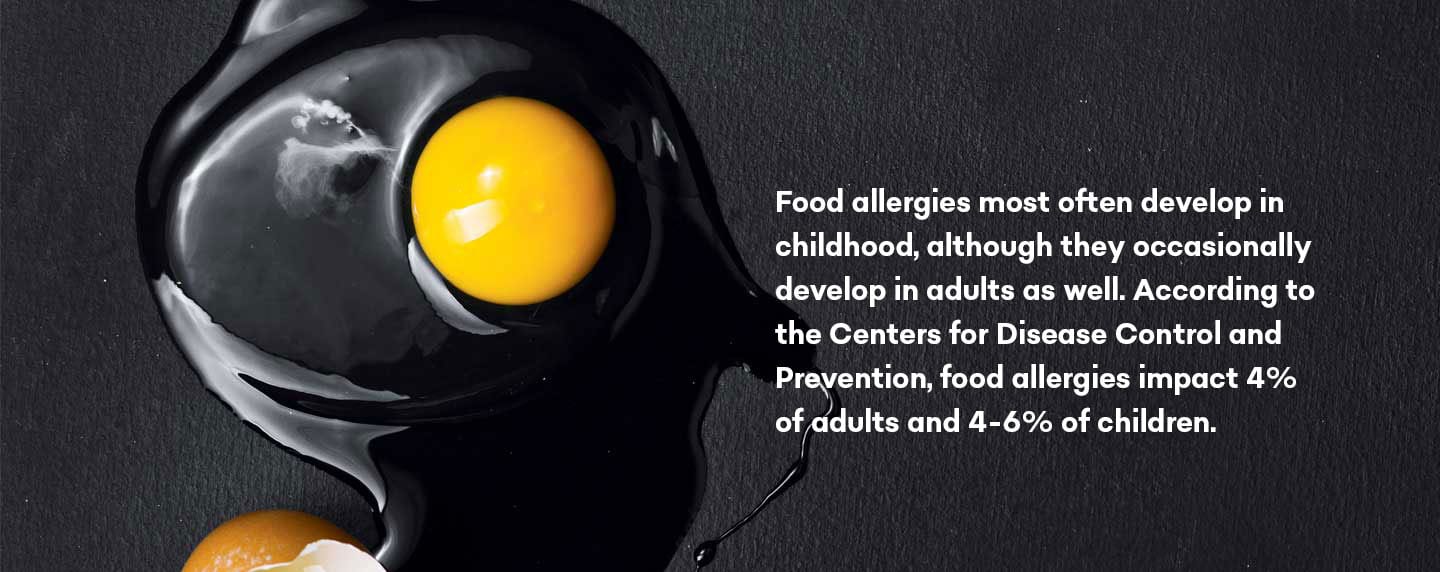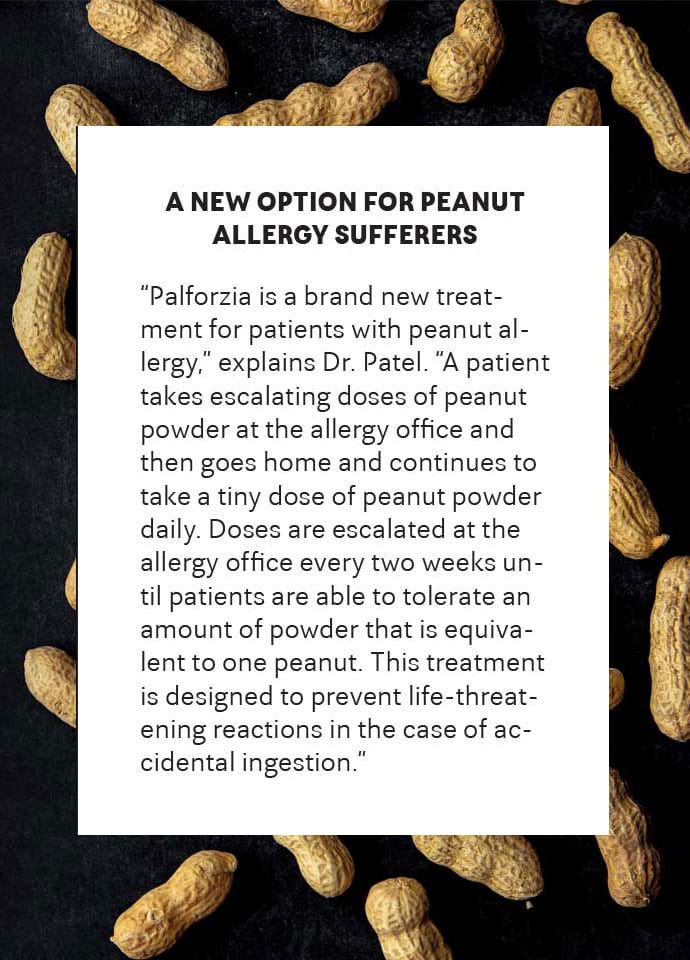What to know about food allergies
to keep your family safe
Each year in the United States, 45,000 people
rush to the emergency room because of a life-threatening
allergic reaction to a certain type of food.
By Camille Platt

The 411 on Food Allergies
A food allergy happens when our body identifies a particular ingredient as harmful and triggers an immune system response. Food allergies most often develop in childhood, although they occasionally develop in adults as well. According to the Centers for Disease Control and Prevention, food allergies impact 4% of adults and 4-6% of children.
Symptoms of a food allergy may appear immediately or up to two hours after ingestion, and the reaction can present as mild or severe. “Commonly, people will experience an itchy rash such as hives and can also have shortness of breath; swelling of their lips, eyes, tongue, or throat; gastrointestinal upset; and/or blood pressure changes,” explains Dr. Jennifer Patel, an allergist with Chattanooga Allergy Clinic.
When the reaction becomes life-threatening, it’s called anaphylaxis. Dr. Susan Raschal, an allergist with Covenant Allergy & Asthma Care, explains, “This is considered the grand slam of reactions because it involves the entire cardiovascular system and can lead to death.” Symptoms of anaphylaxis include restricted airway, swelling or “lump” in the throat that makes it hard to breathe, a rapid pulse, and an extreme drop in blood pressure.
Food allergies can be divided into two types: IgE-mediated and non-IgE-mediated. With an IgE-mediated food allergy, the body releases an antibody called immunoglobulin (IgE) to identify and neutralize what it perceives to be a threat. Each time you eat that food in the future, IgE antibodies sense it and signal for a release of chemicals like histamine in the bloodstream that trigger your symptoms. It’s essentially a misguided attempt to protect you. In a non-IgE-mediated food allergy, which is more difficult to diagnose, the reaction is a bit delayed and symptoms are generally confined to the gut.
The Primary Culprits
There are more than 160 foods that can cause allergic reactions, but the FDA identifies eight as “major,” meaning they account for 90% of all food-based allergic reactions:


Eggs – Eggs are the second most common childhood food allergy. Fortunately, 68% of children will outgrow the allergy by age 16. In some cases, only raw eggs trigger a response.
Tree Nuts – Tree nut allergies, which are generally lifelong, affect only 1% of the population but are responsible for about 50% of anaphylaxis-related deaths.
Peanuts – Peanut allergies are common and can cause severe, potentially fatal, allergic reactions. Today’s recommendations suggest introducing peanut products to babies earlier rather than later, though if a child has severe eczema and/or an egg allergy, he or she should see a specialist first. “Done in conjunction with physician guidance, introducing peanut products early can cut the likelihood of a peanut allergy by over 80%,” explains Dr. Curt Chaffin, an allergist with The Allergy & Asthma Group of Galen.
Shellfish – A shellfish allergy can be hard to identify, since symptoms can overlap with those caused by food poisoning. Sometimes the vapors that come from cooking shellfish can even trigger a reaction.
Fish – Approximately 40% of fish allergies actually develop in adulthood and can trigger digestive symptoms. Just because a person is allergic to shellfish does not mean they’ll be allergic to other fish.
Soy – Soy allergies are more common among infants and children under 3. About 70% of children will outgrow a soy allergy.
Wheat – A wheat allergy is often outgrown by age 10. It is different from celiac disease or celiac sensitivity, meaning people can tolerate gluten as long as the grains don’t contain wheat.
Do I Have a Food Allergy?
If you think you or your child might have a food allergy (and it’s not an emergency situation), it’s important to find a pattern of symptoms so your physician can determine whether it’s a sensitivity or a true allergic reaction. You will need to keep a journal of eating habits along with symptoms, including details such as how long after eating each symptom occurred and duration of each symptom. Next, you’ll need to schedule skin prick testing with an allergist. During this test, your skin will be scratched lightly and exposed to potential allergens. You will wait in the office while your doctor watches to see if any of the spots become red, raised, or itchy, which would indicate an allergy. “Skin testing is the very best way to be tested for food allergies, because a negative test tells us that there’s more than a 95% certainty that the person is not allergic to that food,” explains Dr. Raschal.
Some people are not eligible for skin prick tests because the risk of anaphylaxis is high, they take medications that could interfere with results, or they have a skin condition like psoriasis that would make it difficult to find a clear patch of skin for testing. In those cases, a blood test could be used to look for IgE antibodies. If skin and blood tests are inconclusive, a final option is an oral food challenge, which requires you to eat an ingredient in gradually increasing amounts while under medical supervision. The challenge begins with a small serving of food followed by a 15-30 minute observation period. If you are symptom free, you are asked to eat a slightly larger portion. The appointment progresses from there, with patients who go symptom free for 1-3 hours discharged to go home. If you do have a reaction, you will be kept on-site for observation and care.
Management and Treatment
Avoiding contact with the food that causes you problems is the best way to manage a food allergy. This means carefully checking food labels before consumption every time and being aware of alternate ingredient names that point to your allergen. Soy, for example, may show up on a food label as miso, bean curd, or tofu. If you’re allergic to eggs, you’ll want to watch for ingredients like mayonnaise, albumin, fat substitutes, and meringue. “You’ll also want to think about unexpected cross-contamination,” says Dr. Chaffin. “If you’re allergic to shrimp, you have to consider if that steak you just ordered at a restaurant will be prepared on the same grill.”
Since you can grow out of certain allergies (it’s much more likely to outgrow a milk or egg allergy than a nut or fish allergy), it’s also important to follow up with your allergist sporadically. “We’ll recheck the allergy through skin testing or lab work on a periodic basis to see if you have outgrown them,” Dr. Chaffin explains.
While today’s best advice for managing food allergies is to simply stay away from the food you are allergic to (and to carry epinephrine injectors in case of emergency), there are treatment advancements in the works. Clinical trials for patches are currently being held to test whether slow exposure to your allergen over time could lessen your sensitivity. Ask your physician about new research and options for treatment that could best fit your preferences and lifestyle.
Meet the Experts:


Allergist, Chattanooga Allergy Clinic


Allergist, The Allergy & Asthma Group of Galen


Allergist, Covenant Allergy & Asthma Care

